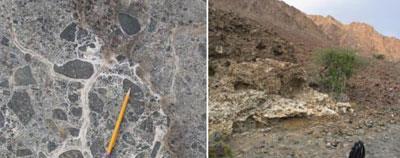Peridotite could mop up billions of tons of carbon dioxide a year, study estimates
Research on a type of rock found mainly in Oman suggests it could be used to mop up billions of tons of carbon dioxide each year without having to be mined, according to US scientists.
Peter Kelemen and J?rg Matter, at Columbia University, US, say that peridotite rock (made mostly of the silicate minerals olivine and pyroxene) reacts naturally with CO2 to lock it away in the form of carbonate much faster than expected, based on 14C dating studies. By artificially accelerating this reaction with heat and forcing CO2 down into the rock through drilled holes, the researchers calculate that Oman’s peridotite alone could lock away over a billion tons of CO2 a year - a significant slice of the 30 billion tons of CO2 emitted annually worldwide by human activity. Peridotite is also found in the Pacific islands of Papua New Guinea and Caledonia, as well as in California.

The idea of capturing CO2 in the form of carbonates inside rock is by no means new. But natural CO2 capture is not very fast, and most schemes suffer from needing energy to mine the rock and spread it over a surface, or bring it to a power plant. Kelemen and Matter suggest that with a little extra heat and some preparation, the peridotite rocks can be left where they are and the CO2 taken to them.
One idea is to pre-heat the peridotite and inject pure CO2 or a CO2-rich fluid mixture. Since the reaction between silicates and CO2 to form carbonates is exothermic, this would keep the rock’s temperature close to the optimum 200?C, maximising the rate of reaction. But CO2 would have to be rapidly pumped into the rock to keep pace with the enhanced reaction rate. This could be a problem, since purifying CO2 from power plant flue gas is extremely energy-intensive, points out Mercedes Maroto-Valer, who works on carbon sequestration at Nottingham University’s centre of excellence for carbon capture and storage.
A second approach avoids this issue by using techniques from the oil industry to drill two holes deep into rock formations below shallow ocean waters, and fracture a path between them. Rock temperatures increase with depth and the temperature at the bottom of a 5km bore hole should be around 100oC.
Cool ocean water containing CO2 could be pumped down one of the holes, and once it reached the bottom, the exothermic reaction would then sustain the high temperatures needed to drive the process. The heated water would eventually find its way through the fractures to the second bore hole and rise to the surface via convection.
While this approach would be limited by the supply of dissolved CO2 to a rate of around 10,000 tons of CO2 per km3 of rock, the costs would be much lower, as circulating water would do the job of transporting the CO2.
The researchers are cautious about the proposals. More elaborate models and field tests would be required to evaluate them, they say.
Matt Wilkinson
Enjoy this story? Spread the word using the ’tools’ menu on the left.
References
Proc. Nat. Acad. Sci., 2008, DOI: 10.1703/pnas.0805794105






No comments yet